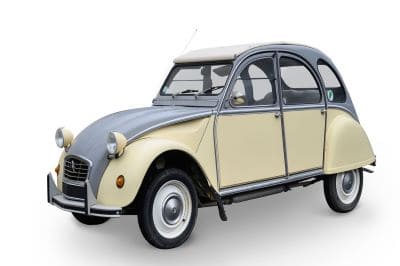UK Car Guide ›› SUV ›› Citroën 4x4 ›› 2CV
Review of Citroën 2CV
The Citroën 2CV first appeared in Paris, 1948. Despite being snubbed and disparaged by many for its "mechanical simplicity", it lasted several decades until they ended production in 1990.
This review of the Citroën 2CV outlines its unique features, technical specifications, and how much it would cost to buy one of the classics in the United Kingdom.
What Exactly Does 2CV Mean on Citroën?
The car name 2CV comes from the French term "deux-chevaux" which loosely translates to "two horses". After forty two years of production, there are several things that made the 2CV special, such as:
- It was a cheap car to buy new (around $1,000 in the 1950s).
- Having an air-cooled engine meant it was easy to service.
- The simple mechanics made it easy to maintain and fuel efficient.
Even though French production of the Citroen 2CV (internal combustion engine) ended in July 1990, you can still buy an environmentally friendly electric 2cEv in the United Kingdom.
2CV's Design Requirements
Many decades ago, the original requirements for the design were specific. The designers of these ancient classic cars said it must be capable of carrying four people and fifty (50) kilograms of cargo at thirty (30) miles per hour across muddy unpaved roads.
The design at the prototype stage was even more outlandish. They wanted a vehicle that could transport a basket of eggs across a freshly ploughed field, with no breakages.
It's fair to say the car nicknamed an "umbrella on wheels" was never luxurious or safe, compared with the range of modern SUVs.
But, in terms of charm and character, you could make a case that the 2CV is a close match with the Fiat 500 and the original mini cars.
Citroen 2CV Engine Size
In contrast to present-day Citroen 4x4 models, the original 2CV is a 375cc engine. This two-cylinder, air-cooled power source thumps out a whopping 9bhp and is capable of reaching a top speed of 40mph.
During the 1960s, a series of upgrades to the flat twin bumped it up to 14bhp and later to 16bhp. 2CV's engine refinements peaked in the 1970s with a 33bhp 602cc motor.
Pro Tip: The Sahara, a factory 2CV 4x4 variant, had two engines. It also had two fuel tanks, and two gearboxes, with a connecting rod between the pair.
Top Speed of Citroen 2CVs
So, is the Citroën 2CV a fast car? Absolutely not - and it was never designed or built for racing around circuits on track days.
 To prove a point, the top speed of the original is about 40mph, and it needs about 43 seconds to achieve it.
To prove a point, the top speed of the original is about 40mph, and it needs about 43 seconds to achieve it.
Even in the 1980s, the fastest versions struggled to break the national speed limits, attaining 71mph (on a downslope).
2CV Tech and Specifications
Despite being a simple car, some of the creative design and engineering is impressive.
It has the standard ladder chassis for the era, made of tubes and a thin steel body bolted on top.
The "self-levelling"suspension is as simple as it gets, and clever at the same time. Its kinematics can "adjust" the wheelbase on one side of the car when cornering under load.
By and large, this legend among classic Citroen cars, means it's almost impossible to flip it on its side. The narrow front tyres and long-travel suspension leads to massive understeering - but it won't roll over.
How Much Does a 2CV Cost?
In fact, you could buy an original 2CV with a 375cc engine for $1,195 in the mid 1950s. But, you should expect to pay upwards of £15,000 in the United Kingdom for vintage Citroen 2CVs.
You might also enjoy reading about...
- Advertise a Used Citroen For Sale FREE in this Website
- Blog Posts about the Automotive Industry Worldwide
- 4x4 Car Insurance Groups With Lower Premiums
- Unavailables: Awesome Cars Not Yet Sold in Great Britain
- Where Can Drivers Go Off Roading in the Kent Area?
- What's the Best Selling Small 4x4 in the United Kingdom?